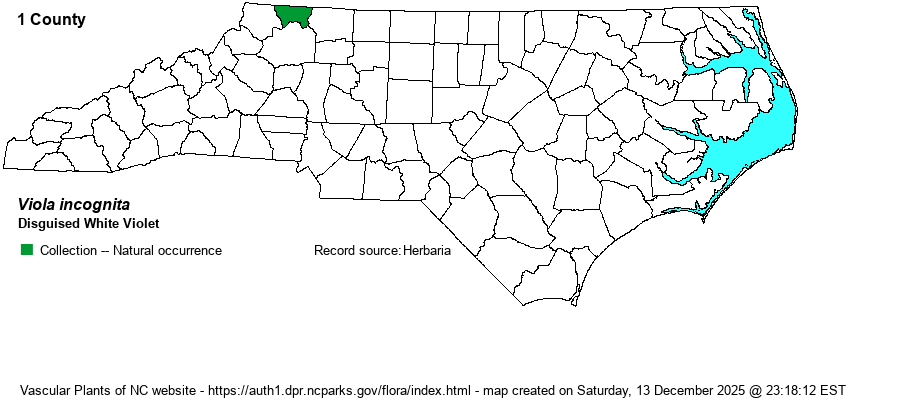| Section 6 » Family Violaceae |
Show/Hide Synonym
| taxonName | relationship | relatedTaxonName | relatedTaxonRefText | relComments |
|---|
|
|
|
| Viola incognita | < | Viola blanda | Gleason and Cronquist (1991) | | | Viola incognita | < | Viola blanda | | | | Viola incognita | < | Viola blanda | Radford, Ahles, and Bell (1968) | | | Viola incognita | < | Viola blanda | Ballard, de Paula-Souza, & Wahlert in Kubitzki (2014). Key adapted, in part, from Ballard (1992) and Ballard & Wujek (1994). | | | Viola incognita | > | Viola incognita var. incognita | Fernald (1950) | | | Viola incognita | > | Viola incognita var. incognita | Gleason (1952) | | | Viola incognita | > | Viola incognita var. forbesii | Fernald (1950) | | | Viola incognita | > | Viola incognita var. forbesii | Gleason (1952) | | | Viola incognita | = | Viola blanda var. palustriformis | | | | Viola incognita | = | Viola blanda var. palustriformis | | | | Viola incognita | = | Viola blanda var. palustriformis | Ballard, de Paula-Souza, & Wahlert in Kubitzki (2014). Key adapted, in part, from Ballard (1992) and Ballard & Wujek (1994). | | | Viola incognita | = | Viola blanda var. palustriformis | Ballard, de Paula-Souza, & Wahlert in Kubitzki (2014). Key adapted, in part, from Ballard (1992) and Ballard & Wujek (1994). | | | Source: Weakley's Flora |
|
| Author | Brainerd | |
| Distribution | Very poorly known, owing to great similarly to and confusion with V. blanda, though believed to occur only in the Mountains. The SERNEC database (2024) lists collections from 7 counties. Moreover, in examining all violet specimens at NCU in July 2024, Harvey Ballard annotated none to V. incognita. A 1958 specimen from Alleghany County, annotated by Derek Poindexter in 2010, appears to be correct. It appears that this species might not currently occur in NC, at least for certain. The Digital Atlas of Virginia Flora shows records scattered in the Mountains south only to Bedford County, though admitting difficulties in identification with V. blanda.
This is a Northern species, ranging from eastern Canada south to DE, PA, and WI, and south in the Appalachians only to western NC, according to Weakley (2024).
| |
| Abundance | Very rare, possibly no valid records for the state. The NCNHP database does not contain this species, nor does NatureServe. Weakley et al. (2024) does, based on Sorrie's data. However, Ballard disagreed with Sorrie and considered the Swain and Yancey records as misidentified. Weakley (2024) shows it as "uncommon" in the Mountains and "rare" in the Piedmont. The website editors have given a tentative State Rank of S1?, and suggest that it should be listed as Significantly Rare. | |
| Habitat | "Moist to wet forests" (Weakley 2018); "Low moist woods and mountain-sides" (Gleason 1952). The specimens accepted as correct by Sorrie are from spruce-fir forests or at least from very high elevations. | |
| Phenology | Blooms from April to June, and fruits shortly after flowering. | |
| Identification | This is an acaulescent (flower stalk without leaves) white-flowered violet, very similar in appearance to V. blanda, and somewhat like V. pallens. Separate this rare-in-NC species form V. blanda by: 1) bearded lateral petals, versus not bearded; 2) petioles and flower stalks green, as opposed to reddish tinged; and 3) the 2 upper petals rather broad versus somewhat narrow. V. pallens is similar but is a smaller species, limited essentially to wooded seepages and other damp forested spots. That species has the leaf stalks and lower leaf surfaces glabrous, as opposed to pubescent petioles and lower leaf surfaces in V. incognita. Though the latter two species tend to have rounded leaf tips, V. blanda can show somewhat obtuse tips, though its leaves are not quite as rounded. As a reminder, this seems to be a very rare species in western NC, and thus nearly all acaulescent white violets will be V. blanda or the infrequent V. pallens. | |
| Taxonomic Comments | Many references do not recognize this species at all as valid, such as NatureServe. In general, it is often subsumed within V. blanda. Some list it as V. blanda var. palustriformis. Interestingly, Fernald (1950) and Gleason (1952) did recognize this as a good species, as do a few recent references.
General note on Viola: In 2009-10 B.A. Sorrie (website map editor) went through the whole collection at NCU, annotating all specimens against those verified by experts in the genus. The range maps in RAB (1968) have been changed accordingly. More recently, Harvey Ballard and colleagues are in the process of revising all Eastern and Southeastern Viola, and have annotated all specimens at NCU in July 2024. They recognize additional species not in RAB or in previous editions of Weakley et al.; we will follow updated editions of Weakley et al. in recognizing them. Species range maps have been adjusted to account for identification changes. | |
| Other Common Name(s) | Largeleaf White Violet | |
| State Rank | [S1?] | |
| Global Rank | GNA | |
| State Status | [SR-P] | |
| US Status | | |
| USACE-agcp | | |
| USACE-emp | | |

